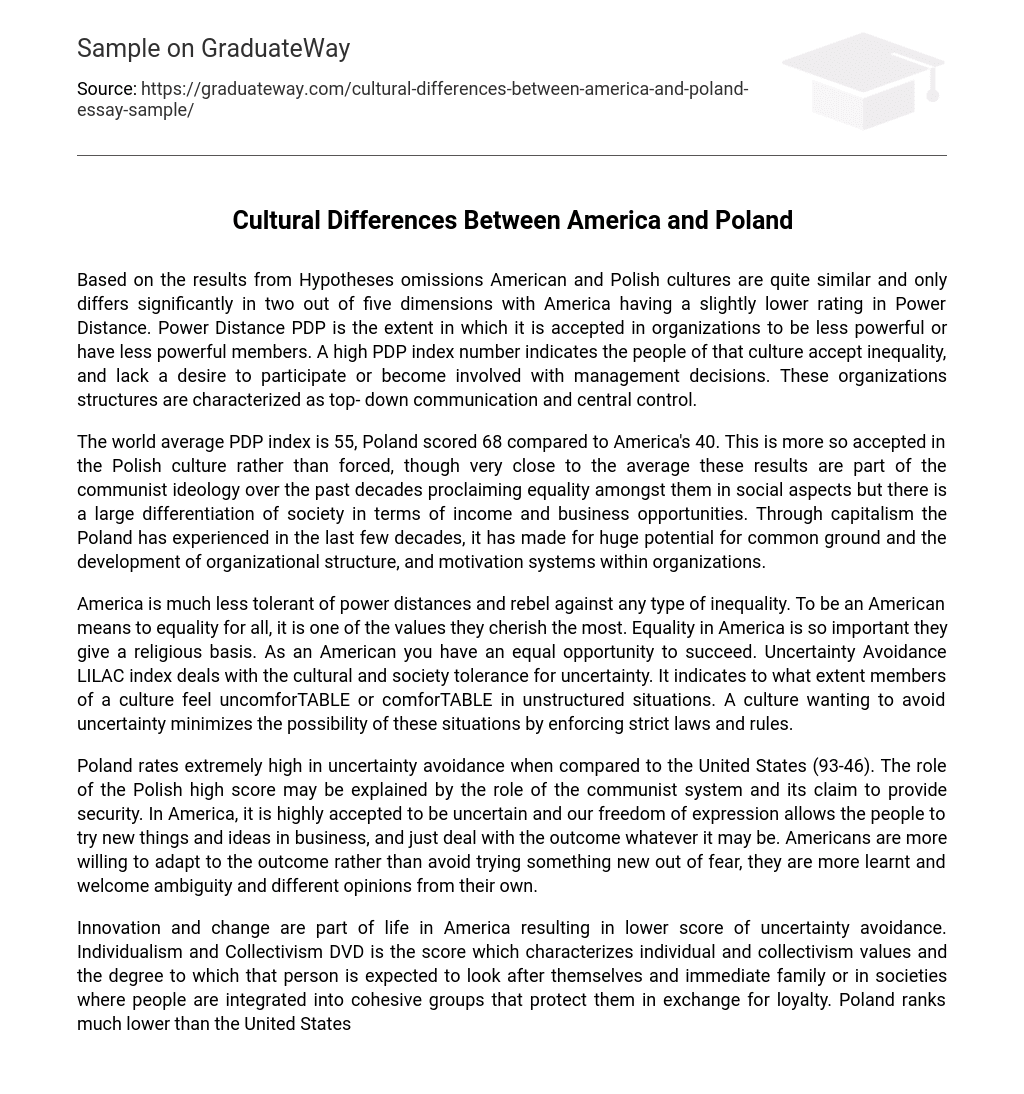Based on the results from Hypotheses omissions American and Polish cultures are quite similar and only differs significantly in two out of five dimensions with America having a slightly lower rating in Power Distance. Power Distance PDP is the extent in which it is accepted in organizations to be less powerful or have less powerful members. A high PDP index number indicates the people of that culture accept inequality, and lack a desire to participate or become involved with management decisions. These organizations structures are characterized as top- down communication and central control.
The world average PDP index is 55, Poland scored 68 compared to America’s 40. This is more so accepted in the Polish culture rather than forced, though very close to the average these results are part of the communist ideology over the past decades proclaiming equality amongst them in social aspects but there is a large differentiation of society in terms of income and business opportunities. Through capitalism the Poland has experienced in the last few decades, it has made for huge potential for common ground and the development of organizational structure, and motivation systems within organizations.
America is much less tolerant of power distances and rebel against any type of inequality. To be an American means to equality for all, it is one of the values they cherish the most. Equality in America is so important they give a religious basis. As an American you have an equal opportunity to succeed. Uncertainty Avoidance LILAC index deals with the cultural and society tolerance for uncertainty. It indicates to what extent members of a culture feel uncomforTABLE or comforTABLE in unstructured situations. A culture wanting to avoid uncertainty minimizes the possibility of these situations by enforcing strict laws and rules.
Poland rates extremely high in uncertainty avoidance when compared to the United States (93-46). The role of the Polish high score may be explained by the role of the communist system and its claim to provide security. In America, it is highly accepted to be uncertain and our freedom of expression allows the people to try new things and ideas in business, and just deal with the outcome whatever it may be. Americans are more willing to adapt to the outcome rather than avoid trying something new out of fear, they are more learnt and welcome ambiguity and different opinions from their own.
Innovation and change are part of life in America resulting in lower score of uncertainty avoidance. Individualism and Collectivism DVD is the score which characterizes individual and collectivism values and the degree to which that person is expected to look after themselves and immediate family or in societies where people are integrated into cohesive groups that protect them in exchange for loyalty. Poland ranks much lower than the United States, this may mean polish society fosters strong legislations where one takes responsibility for fellow member of their group.
This is in part due to years of a collectivist society under communist ruling. Poland can be individualistic to a certain degree but they still seek social recognition. In organizations, Polish people expect to be rewarded for individual contribution, bit accept when they are not. Americans resist being though of as a group, although they may do things in a group, they often feel they are different or more unique than anyone else in the group. In organizations teamwork is often defined by individual roles within the team, ND you receive recognition for your part or what you have contributed.
Masculinity MASS is the distribution of roles between genders in society. Men’s values in society tend to be more assertive and competitive. Polish and American cultures represent a more masculine assertiveness. The scores are extremely close (62-64) Long Term Goals L TO values are associated with perseverance, while values associated with short term orientation are about respect for tradition and social obligations. Poland has endured a difficult history, and holds the family sacred. The scores of both Poland and America are quite similar.
In America they are hopeful that the future will bring greater happiness, and most of their energy is directed toward that future. Americans strongly believe in themselves and that they have control, this has made them very successful in short term projects and goals. Conclusion USA is much larger and more powerful than Poland. At one time Polish- Athenian was the largest state in Europe, though the size did not equal in political power, nor was it considered to be powerful such as England or Netherlands which were smaller in size but considered to be much stronger.
The USA is powerful dominating country that couldn’t possibly be ignored throughout other nations. America dominates Polish in technology and business. Though American markets are over saturated, and the people know very little about cultures and countries outside their own, those in Poland are very interested in knowing about the United States because or its history Of prosperity. Poland is a small country, it does not have oil and any tourist attractions and it is only known for its struggle for freedom from communistic oppression from the Soviet. The American and Polish outlook towards the oral is completely different.





